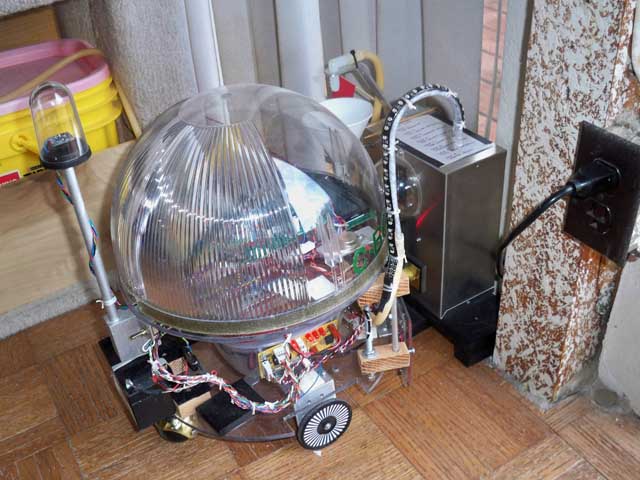
|
CBOT-1: Plant Watering Robot Final Report Certainly one of the most complex robots I have ever built, this robot was not only the first to use the highly advanced CCS-C compiler for writing the code which controlled the robot, and employed navigational techniques that had not been used before in any of my previous robots. As many of you know, the robots construction and programming was done incrementally, each step building on the last to bring together the complete robot. Here you will find a overview of worked and what did not, and some thoughts on the future next generation of Plant Maintenance Robots. What worked really well CHARGING CONTACTS
AND DOCKING PLATES BEACON HOMING AUTO FILLING PUMPS
AND CIRCUITS WATERING TUBE AND
FUNNEL SONAR DISTANCE
NAVIGATION WATERING ON TIME
SELECTOR ADAFRUIT DIGITAL
MAGNETOMETER WATERING TRUTH
CUP What did NOT work very well ORIGINAL DRIVE
MOTORS AUDIO SOUNDS SYSTEM USING DUAL GEAR
HEAD MOTORS FOR DIFFERENTIAL DRIVE WATER LEVEL INDICATORS BACKLIGHT ON LCD
DISPLAY RAN OUT OF PROGRAM
MEMORY DOCKING BACKUKP
FLAG Future changes for the next version of CBOT. The next upgrade will occur after the plants have been harvested for peas and radishes. The primary goal is not only to free up all the processor memory by offloading sensor data to separate processors, but to improve the accuracy in reaching each planter and increase the number of planters to include a more extensive robot garden project. Electronic / Mechanical improvements: -- Replace drive
motors with stepper motors and add driver boards |
|
Interested in learning more on the development of this robot? Here are previous uploads - LATEST AT THE BOTTOM: Previous Articles 1. Plant watering sensors 2. Cbot basic concepts and project definition 3. Docking sensor, battery charging and FSM explained 4. Development of the water tank, pump and feed mechanism 5. Development of the reservoir refill system 6. Incorporating the Triple axis magnetometer for compass navigation 7. Installing the final components - Bumper Switch Array 8. Night - Day - Night Detection to trigger watering task 9. Planter Water Distribution System for Autonomous Watering 10. Plant progress upstairs after two weeks! 11. Two months in operation |